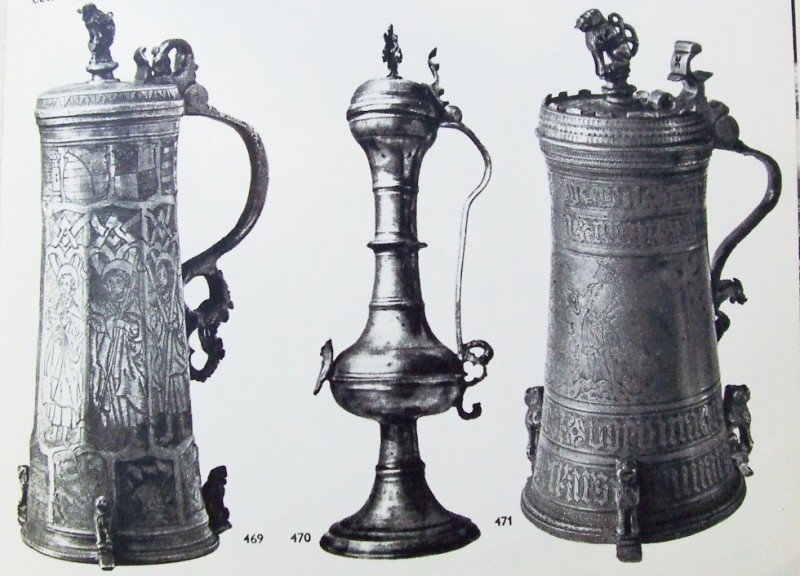![GAMBRINUS LID - ON 1990'S [NEW] MOLDED GLASS STEI IN GERM 8-12](http://www.steveonsteins.com/wp-content/uploads/2011/01/GAMBRINUS-LID-ON-1990S-NEW-MOLDED-GLASS-STEI-IN-GERM-8-12.jpg)
GAMBRINUS – THE KING OF BEERS
http://www.steveonsteins.com/gambrinus-the-king-of-beers-draft
Gadrooning — A surface decoration composed of a series of parallel, smooth, rounded ridges juxtaposed vertically, or sometimes set diagonally or in a swirling pattern. In appearance, gadrooning is the opposite of fluting.
A very good example of gadrooning on an English Sterling tankard, marked for year 1741. See the page: “For sale” for more information about this piece. [FWTD]
![CR- GADROONING ON ENGLISH SILVER TAKARD - DTD 1741 [FWTD]](http://www.steveonsteins.com/wp-content/uploads/2011/01/CR-GADROONING-ON-ENGLISH-SILVER-TAKARD-DTD-1741-FWTD.jpg)
Gambrinus – The legendary “King of Beers.” Please see the article about him under the Tab, this web site: “Stein Myths, Misnomers ”
See: http://www.steveonsteins.com/beer-stein-dictionary-1
The name of Gambrinus became synonymous with German beer in the 1800’s and well into the 2000’s. Several well thought of beers were imported in to the US from Mexico by the “Gambrinus Export Company.”
“The King ” portrayed on a bronze wall panel ▼ made by Dehls and Stein in Newark, NJ, USA in the late 1930’s. [tsaco]
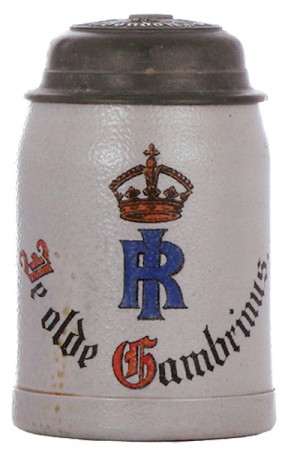
Trading on the King’s name on an older Germany brewery stein.
Gambrinus Beer Stein (Collectors) Club of Va., Md., and DC. – Collector’s group started by “himself” in 1971 and still going fairly strong.
Here’s a much older photo of “Steve” as a young 40’s something. “Himself’ and Milton Schnitzlien, Gambrinus Chapter of SCI. in 1982! (Check out the ‘Marlboros’ in my pocket! I quit over 28 years ago and still got throat cancer!)
For some more recent photos of Gambrinus’s activities and stein sales please GO TO : http://picasaweb.google.com/GambrinusDC

GAMING BEAKERS – ENGLISH, PAIR OF OLD SHEFFIELD PLATE DICE BEAKERS ASKING $1,495 ON EBAY 8- 2013
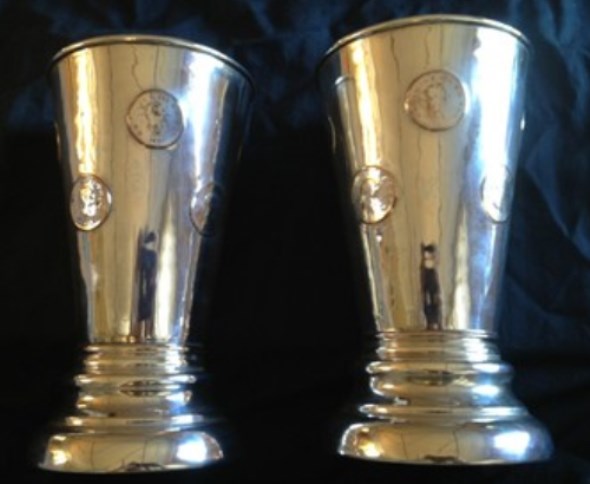
Ganseliesel – SEE: ‘Goose Girl’
Gaudy – this is the visual definition ▼.
Gentleman Fox – Steins and art portraying the (German) Fox as a gentleman and not the vicious little killer he really is.
▼An old German postcard, where Fox and Rabbits are buddies and drinking a beer or two together.
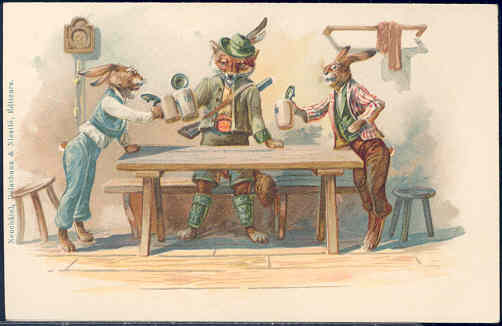
The Schierholtz’s version of a porcelain “Gentleman Fox. Also see: Fuch (Fox) in the Compendium.
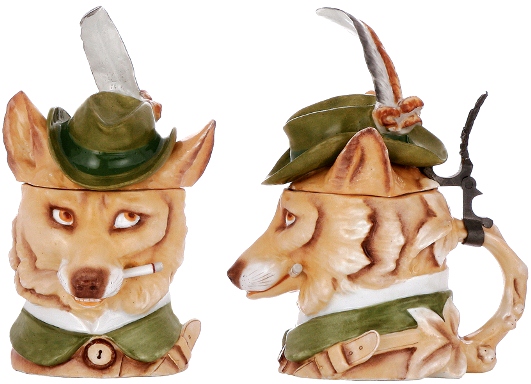
“Gebrüder Bing” – SEE: Bing Brothers, also Claret jugs
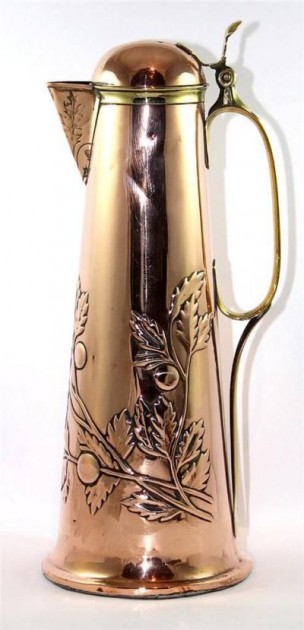
Geometric (designed) steins. Steins having as their decor, raised or incised standard geometric designs such as body rings, flutes, gadroones, circles, cubes, hearts, swastikas, etc etc. Anywhere else in the world that is what these are called, But US stein collectors especially “Mettlach” stein collectors call them “Mosaics”. Go figure!
Shown: A nice 3 liter Majolica geometric designed server. Marked WS &S [59] [tsaco]
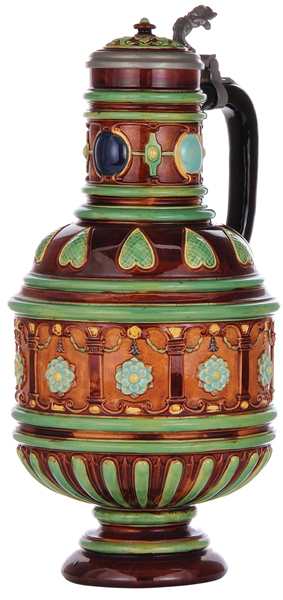
GEORGE PULL – ENGLISH – MAJOLICA STEINS
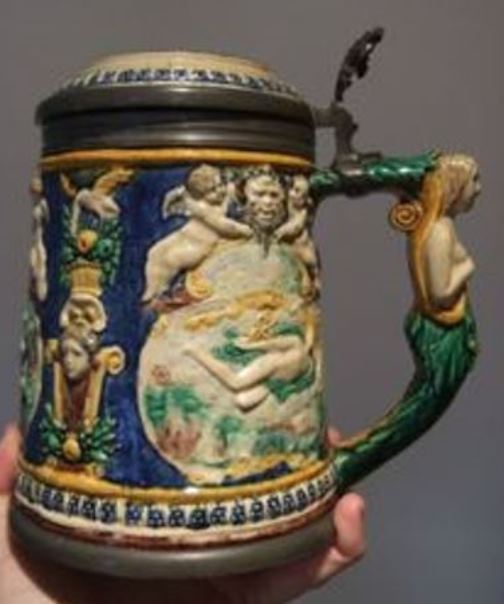
GEORGE PULL – MAJOLICA SERVER
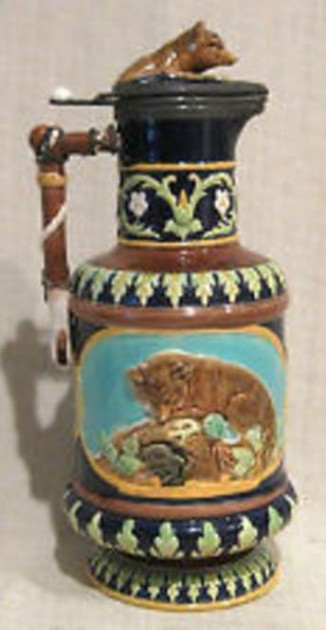
The infamous English fox, another by Mr.Pull
“George Rex” Steins and mugs – See “G-R” below ▼
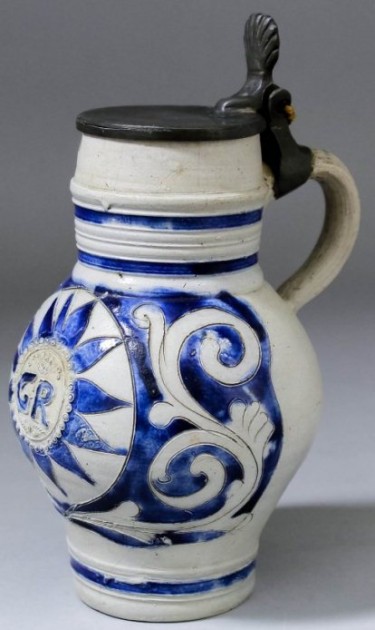
“ George Washington” steins – If it is not “Washington crossing the Potomac (sic)” as one super intelligent eBay seller wrote about the Whites of Utica beer server showing Washington in the boat going across the Delaware River; then it will probably be something like this one. Can you guess why? I have seen it happen [!] even with Fredrick the Great’s initials shown on the stein!
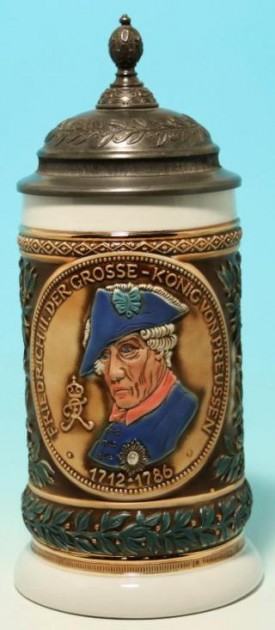
Gerharz & Manns, – Westerwald Germany, Incised Stoneware Pitcher▼.
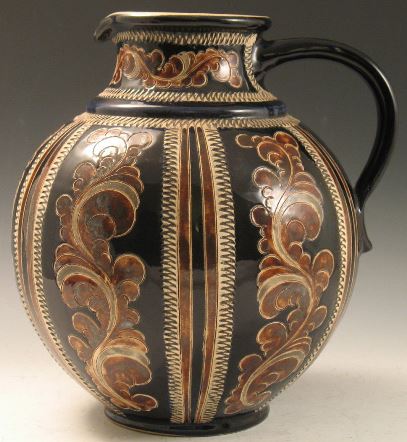
Very similar to a Wm Muhlendyck’s esp. the brown color used all over.
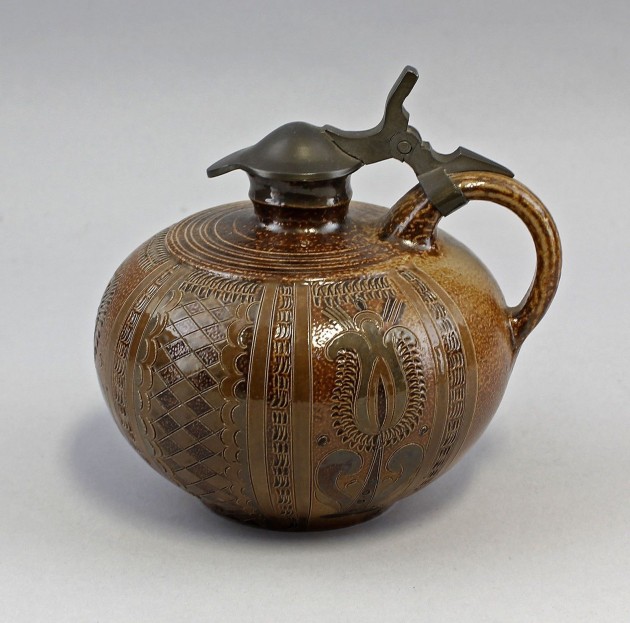
see” http://www.steveonsteins.com/wim-muhlendycks-animal-steins
German print/ old script (on steins) – See article written by SCI’er WALT VOGDES on this infamous “pay for beer stein information “web site.
http://www.beerstein.net/articles/s9412a.htm This info is however on the free list!!
German silver – An silver white alloy made of zinc, nickel and copper. The usual formulation is 60% copper, 20% nickel and 20% zinc. After the First World War this term was changed to “Nickel Silver” due to the dislike of most all things German. It is also known as German silver, Argentan, new silver, nickel brass, albata, alpacca, or electrum, . Nickel silver was named for its silvery appearance, but it contains no elemental silver unless plated. The name “German silver” refers to its development by 19th-century German metalworkers in imitation of the Chinese alloy known as paktong (cupronickel) EPNS = ELECTRO PLATED ‘NICKEL SILVER.
German silver standard (Not to be confused with ‘German Silver”. the alloy) – The official standard is use in Germany since 1888 is .800 or 800 parts per thousand. This compares with .925 which is “Sterling”, the standard used in England since the late 1500’s and in the USA since about 1886 when Gorham Silver Co. initiated it.
Germania – She is usually shown as a robust woman with long, flowing, reddish-blonde hair and wearing armour. She often wields the “Reichsschwert” (imperial sword), and possesses a mediaeval-style shield that sometimes bears the image of a black eagle on a gold field. Additionally, she is sometimes shown as carrying or wearing the Imperial Crown of the Holy Roman Empire.
A photo showing the quality of older steins from “Reinhold Merkelbach.” See; “R” in Compendium). “Germania” is the body’s subject.
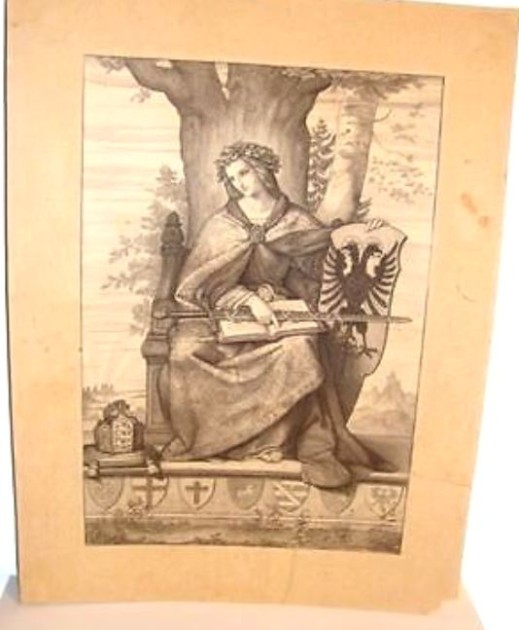
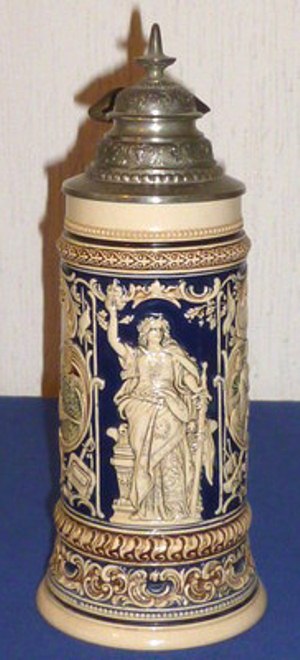
Germania, Statue of – (Niederwalddenkmal) – The Niederwalddenkmal is a monument located in the Niederwald Landscape park, near Rüdesheim am Rhein in Hesse, Germany. The monument was constructed to commemorate the foundation of the German Empire after the end of Franco-Prussian War. The first stone was laid on September 16, 1871, by Wilhelm I. The sculptor was Johannes Schilling, and the architect was Karl Weisbach. The total cost of the work is estimated at one million gold marks. It was inaugurated on September 28, 1883. The 38 metres (125 ft) tall monument represents the union of all Germans.
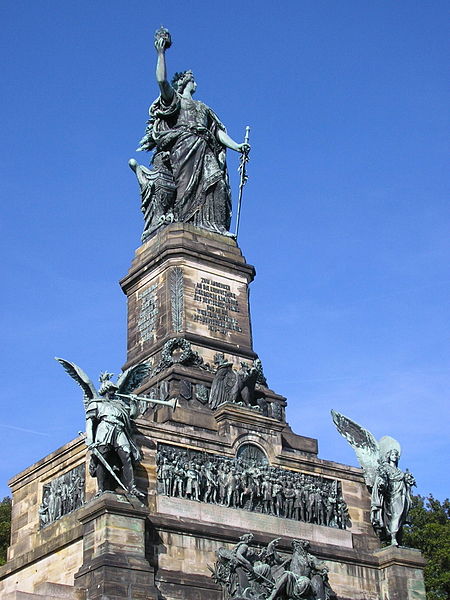
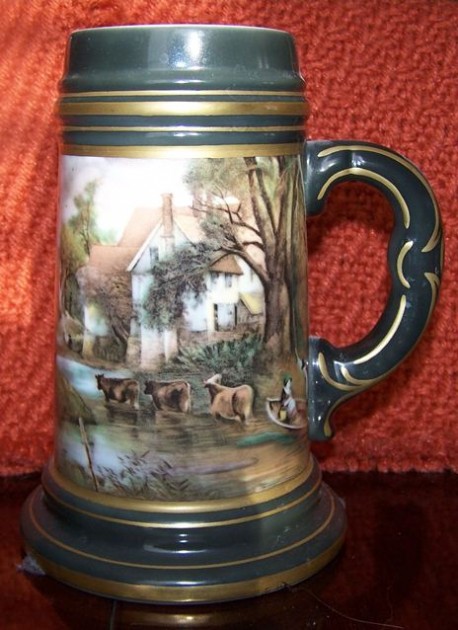
Gerold Porcelain –
Photos used with permission of the editor, Ms. Joann Snow. See her very comprehensive web site at: http://www.gerold-porzellan.com/steins.htm.
.5 liter mug done in the older style of the regimental reproductions (a bump inside the handle) and associated lithophane.
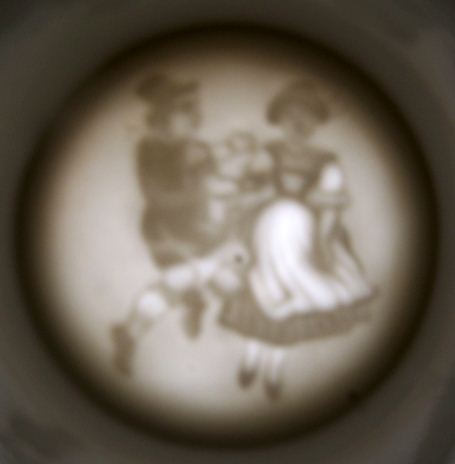
.5 liter puzzle mug and the associated lithophane.
.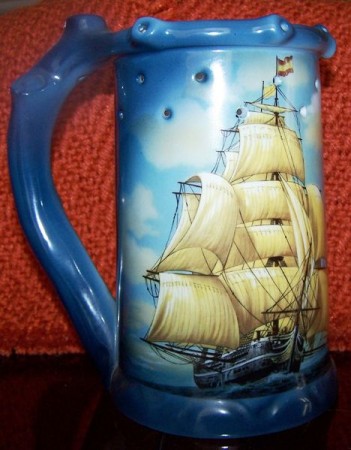 .
. 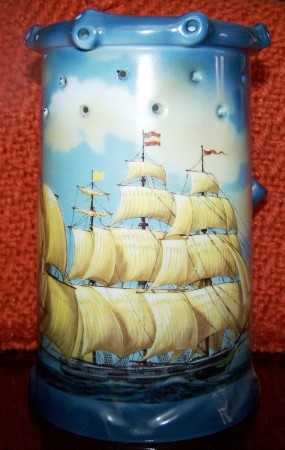
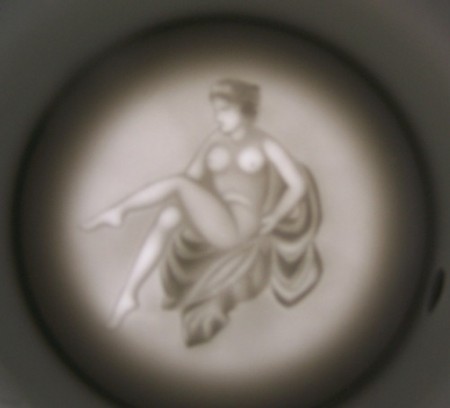
Gerz, Simon Peter – A very long running German pottery beer stein firm. See: http://www.steinmarks.co.uk/pages/pv.asp?p=stein1
Gerz, “Limited Edition” steins series – A [NOT VERY] “Limited Edition” series of ceramic steins made by Gerz in the 1980 -90’s that replicated the styles of earlier steins, mostly from the 1700’s. Save you money and buy a real one. Shown below and above: their copies of early Westerwalds.
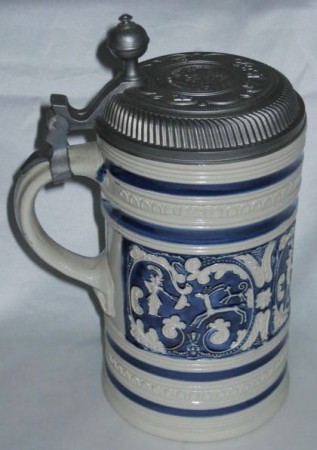
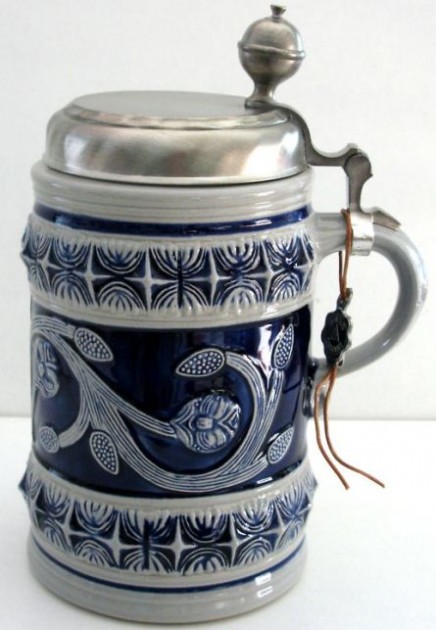
Their Altenburg copy in that series. It is doubtful anyone but a brand new off the boat stein collector would really call this a masterpiece.
![Gerz Masterpieces [HA] Gerz Altenburg Tankard German Limited Edition Stein](http://www.steveonsteins.com/wp-content/uploads/2011/01/Gerz-Masterpieces-HA-Gerz-Altenburg-Tankard-German-Limited-Edition-Stein.jpg)
GERZIT – MARK OF THE RECONSTATUTED GERZ BEER STEIN FACTORY. ▼ HAND PAINTED LIDDED 5.75 IN.
“GESETZLICH GESCHUTZT” – Mark on the bottom of steins meaning the design was numbered and registered in the equivalent to our “Patent Office “
Gilding – The application of a gold color to silver (and other metals esp. copper) either: (1) by melting gold with mercury and painting it onto the surface with a brush, before removing the mercury by evaporation under heat, causing the two metals to fuse; (2) by soaking a linen rag in a solution of chloride of gold, burning it and rubbing the ashes onto the silver, which adhere; or (3) by modem electrolysis. Gold is the only metal that doesn’t oxidize. SEE: Gilt
This stein’s copper body was almost black, but the gold rim and handle mount, thumblift and lid mounts (holding miniature enameled rainbows were still bright. This one is probably ‘unique’, 20 inch tall, handmade, unmarked brass body stein, with gilt mounts, etc, and a low silver content lid, with enameled cloisonne rainbows around its lip. [FWTD]
GILDED ENGRAVING – COAT OF ARMS FOR TOWN OF MEISSEN [QUEST] RFA
![CR- GILDED ENGRAVING - COAT OF ARMS FOR TOWN OF MEISSEN [QUEST] RFA](http://www.steveonsteins.com/wp-content/uploads/2011/01/CR-GILDED-ENGRAVING-COAT-OF-ARMS-FOR-TOWN-OF-MEISSEN-QUEST-RFA-283x630.jpg)
Gilt – A process of applying a small layer of gold on top of another metal. It used to be done with an acid (deadly to the workers.)
![Gilded Brass [WRONG IT iS PAINTED SPELTER] Relief 10L. 29 IN tall. Battle scene. Large warrior finial.](http://www.steveonsteins.com/wp-content/uploads/2011/01/Gilded-Brass-WRONG-IT-iS-PAINTED-SPELTER-Relief-10L.-29-IN-tall.-Battle-scene.-Large-warrior-finial.-220x630.jpg)
US auctioneer recently called this one.:” Gilded Brass”, Relief, 10L (SIC). 29 IN tall. Battle scene. Large warrior finial. BESIDES THE CAPACITY THIS IS WRONG ON TWO OTHER COUNTS! IT IS PAINTED GOLD ON SPELTER (MOSTLY ZINC)!
Ginori porcelain – See [1]the original Green Vaults ivory version(and others) of this stein, web page: http://www.steveonsteins.com/silver See[2] :Green vault’s steins below this page Also see “Capo-di-Monte” in this site’s “Compendium.” [FWTD]
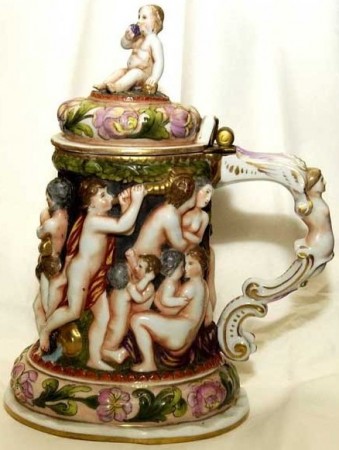
Giraffe skin finish – self explanator . SEE REPTILE SKIN TOO
![CR- GIRAFFE SKIN [Q] - LOOK UP SEE REPTILE SKIN TOO](http://www.steveonsteins.com/wp-content/uploads/2011/01/CR-GIRAFFE-SKIN-Q-LOOK-UP-SEE-REPTILE-SKIN-TOO.jpg)
Girmscheid, Mathias – Pottery stein maker. One of the top 10 collected. See: http://www.steinmarks.co.uk/pages/pv.asp?p=stein1
G K – An unidentified artist [as of this date ~ 2-15-2014 ] who worked for Girmscheid. ▲
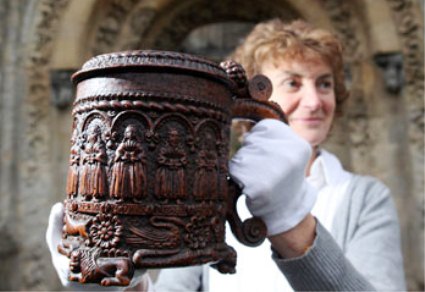 Glastonbury tankard / Grace cup – One of the most famous tankards in English history. No sense in re-writing all that has been said about this piece, so please read these in this order:
Glastonbury tankard / Grace cup – One of the most famous tankards in English history. No sense in re-writing all that has been said about this piece, so please read these in this order:
[1] http://www.thehistoryblog.com/archives/13988
[2] http://www.steveonsteins.com/why-the-lids-real-reason – At the section that starts: “THE GLASTONBURY TANKARD.”
Father along in his book Mr. Monson-Fitzjohn pictures a very nicely carved wooden tankard [beer stein], and includes the following information about it
As I said on the above page, the history of the tankard shown (and above) and the age of the stein in the photo do not match; NOT EVEN CLOSE, so it appears to be just another myth!
While billed as the “Glastonbury Tankard” on ‘Goggle’ the stein above is much newer. I think the piece shown is no older than the late 1600’s, if that! And of Scandinavian origin and not English!
Also it is a “peg tankard,” and it is referenced at: http://www.steveonsteins.com/wooden-stein
Glaze — A hard, impervious coating fired on to ceramic materials, it can be clear or colored, transparent or opaque, matte or glossy; clay glazes are like slips and were used on very early ceramics, other glazes are all forms of glass made from powdered glass, feldspar, borax, salts, or metal oxides; lead glaze is found on Hafnerware and folk pottery; leopard glaze is a strong brown-speckled salt glaze found especially on Frechen wares; salt glazes are produced by pouring large quantities of salt into the furnace at its peak firing temperature — the sodium chloride reacts with water (hydrogen oxide) to produce a glassy coating (sodium oxide) and hydrochloric acid vapors; tin glaze, as commonly used on faience, is made from tin oxide.
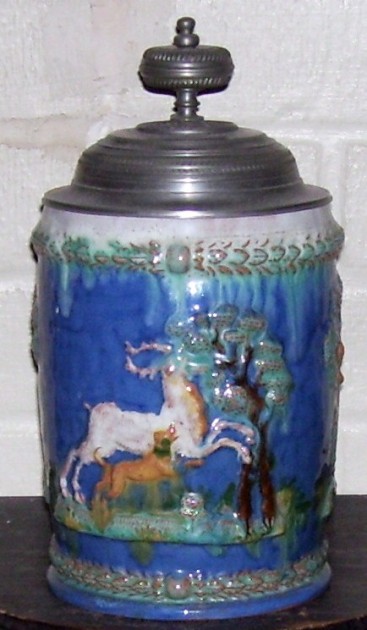
Shown above ▲: A one liter Münchener Werkstätten fürKeramische Kunst , Ca. 1910 stein. The firm used a lead glaze. See: Fayence,Delftware, Majolica, Saltglazed; all in this site’s “Compendium.” Also see: http://www.steveonsteins.com/german-majolia-beer-steins-new-7-24-12 [and] http://www.steveonsteins.com/majolica-english-type-or-lead-glazed-drinking-vessels-from-the-munchner-werkstatten-fur-keramische-kunst-the-munich-workshop-for-pottery-artwork
Gmunden – A large Austrian Fayence stein manufacturing center in the 1800’s.
A 1/2 liter stein from this city showing its typical blue and green colors. Circa 1830. See also: “Fayence, Austrian” in this site’s Compendium. [FWTD]
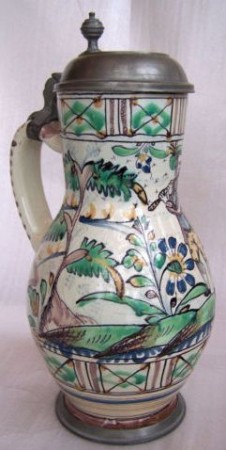
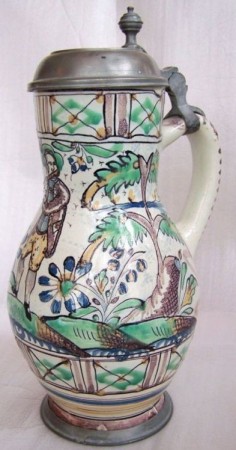
Gmunden [2] – Below a Fayence “A Friendship deer. ” (not a hunter’ s)
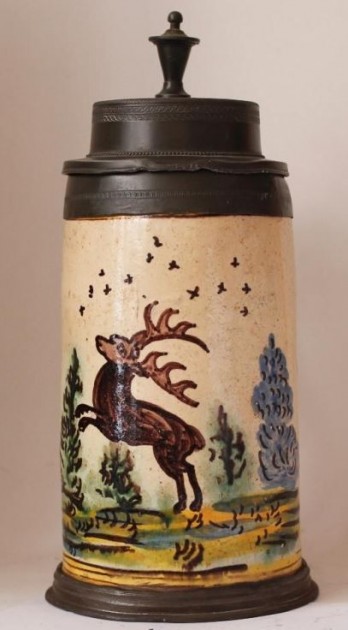
Gnomefest – On “Gnome Hill” (somewhere in Virginia) – Self explanatory, I believe.
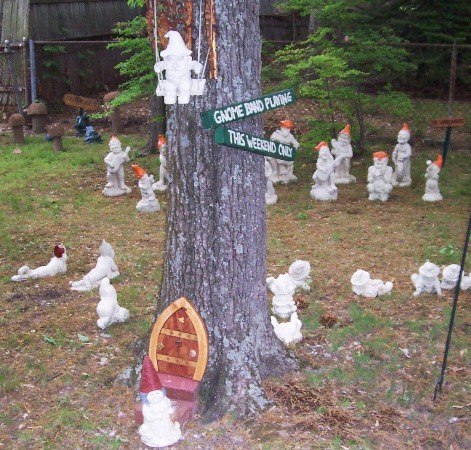
Below▼ Detail off a .5 liter relief pottery stein. Gnomes make a great sub-set of stein collecting as there are probably 1,000’s of designs.
See: http://www.steveonsteins.com/dwarfs-gnomes
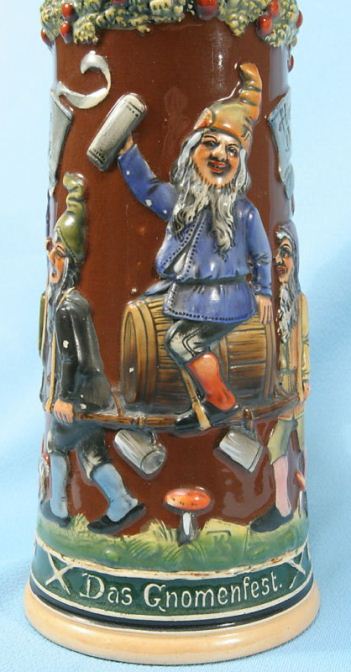
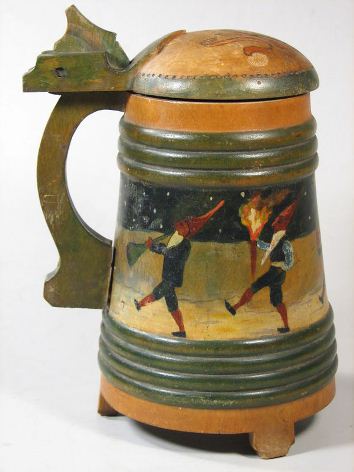
Left: AGerman 2 liter pottery relief ca. 1890. . Right: A hand painted on wooden staves, Scandinavian gnome fest, held at night Ca. 1910 [FWTD].
Gnome King – “Das Gnome Konig Andvari”, shown drinking on a Mettlach server, 2.5L, 956[2178], PUG, by H. Schlitt. [tsaco]
For more on gnomes. please see: http://www.steveonsteins.com/dwarfs-gnomes
![GNOME KING - Mettlach stein, 2.5L, 956[2178], PUG, by H. Schlitt, pewter lid, TSACO 7-13](http://www.steveonsteins.com/wp-content/uploads/2011/01/GNOME-KING-Mettlach-stein-2.5L-9562178-PUG-by-H.-Schlitt-pewter-lid-TSACO-7-13-582x630.jpg)
Goblet – An English word for a really undefinable shape of a drinking vessel closely related to the “chalice” form. The term usually refers to a wine glass from small to medium size, but has now been so diluted in meaning as to be almost worthless as a descriptor. Shown above▲ Besides chalice and wines , these are also called stemmed beakers
A 6.8 inch, engraved (not etched) gilded silver goblet. Russian, dated 1881.
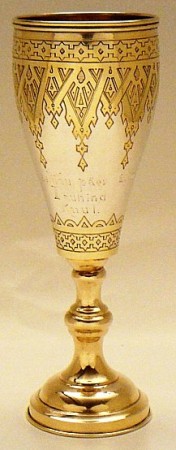
Bronze, goblet with applied reliefs and grotesques. Austrian. [?] Circa 1850.[FWTD]

▲ A silver plated example made by by WMF;
shown just below▼ with a little brass “bleeding” through.
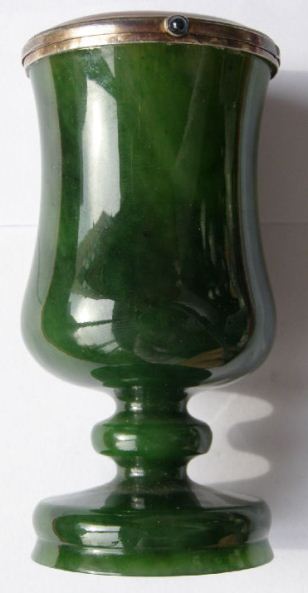
Advertised on eBay [2012] as: Goblet, 19th C Imperial Russian Nephrite, silver mounts. A very nice looking wine goblet.
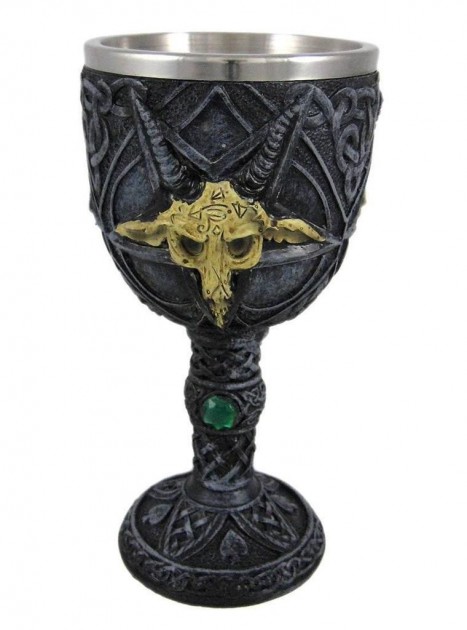
Fantasy goblet advertised as “Medieval Style “, Wiccan, Pagan Wine Goblet. Will things like this be the antiques of tomorrow? I believe this Wicca fad started in the 1990’s and then really took of with the Harry Potter movies later.
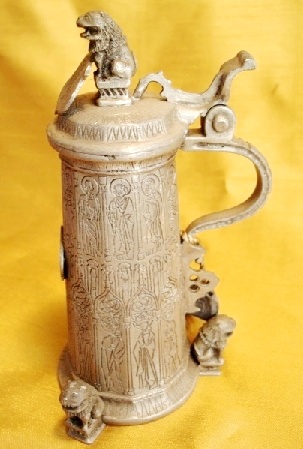
Goebel miniature pewter steins – A series produced (1990’s?) of small pewter replicas of very old steins by Goebel (known for the figurines), in Germany. Shown ▲: One of the series.
CR- GODS AND GODESSES – MINURVA LOOK UP
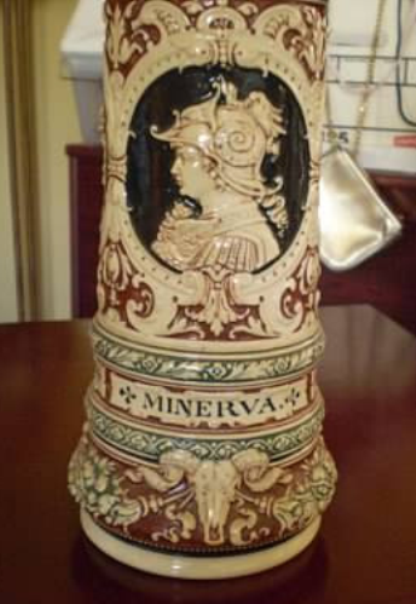
Geobel, House of – Goebel Porzellanfabrik is still owned by the Goebel family whose leadership of the company is in its fifth generation.
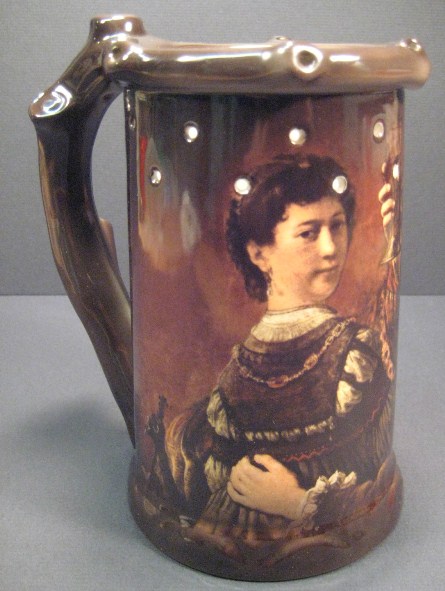
Shown above ▲: A new “puzzle mug” with nude lithophane in the bottom. 7 inches tall. Shown below: House of Goebel – a new ” Mini-lidded “Regimental” stein, with no unit or owner designations — 5.25 Inch. A waste of good ceramic atoms! 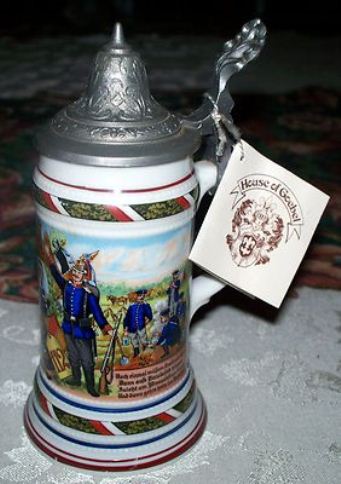
Goebel Merkelbach (West Germany) – Yet another buy out of an older stein firm by a larger ceramics giant. This Gnome, a .5 liter pottery character stein was on eBay in 2-2013 and called “Very Rare!“ Yes I did laugh!
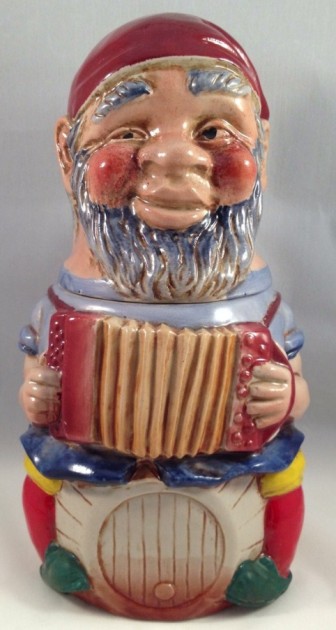
Goedewaagen – A ‘Delft’ porcelain mug maker. Newer items.
Goeggingen 1748-1752 – City or town of major fayence stein production. For more info, see: http://www.thepatriotexchange.com/pss/hisfai.htm
Gold Plating — The covering of an article with gold by electrolysis. See: Gilding.
Golf steins – Porcelain stein, .5L, hand-painted, marked C.A.C., Lenox, sterling silver lid Several years back these were all the rage, however there were only maybe 3 or 4 collectors willing to pay the very high prices at the USA auctions and only for a few years. As with most anything in the Antique World, that is over challenged, the boom soon died away. [tsaco]
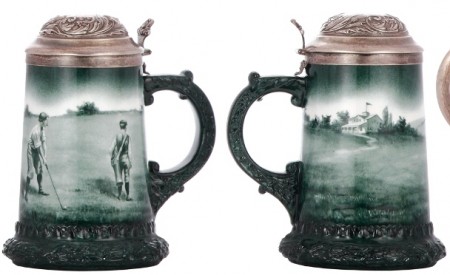
Goose girl – (Ganseliesel) -A Grimms’s fairy tale of the princess who became a goose girl before she could become queen. Anidori-Kiladra Talianna Isilee, Crown Princess of Kildenree, is born with the ability to speak to animals, a gift that is nurtured by her aunt. When the king dies, the queen announces that Ani’s younger brother, not the crown princess, will succeed her on the throne. Unbeknownst to anyone, the queen has promised Ani in marriage to the prince of neighboring Bayern. The devastated teen is sent with a retinue over the mountains to Bayem and is betrayed by Selia, her lady-in-waiting, and most of her guards during the journey. Ani escapes, takes the name “Isi,” disguises her distinctive blonde hair, and becomes a tender of geese to survive until she can reveal her true identity and reclaim her crown from the imposter, Selia. Ani meets and falls in love with Geric, who is, conveniently, the prince she is to marry. She is able to convince him and the king of her identity, marry, become queen, and stop a war between the kingdoms. This retelling retains many similarities to the original tale, including the gruesome punishment for treason. Seen on many “kinder” mugs and steins as above. [FWTD]
See: http://www.steveonsteins.com/kinder-steins-page-1-13rd-of-article-text-only
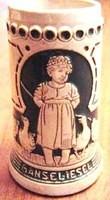
Goose man = Gänsemännchen – A small, but life-like bronze sculpture of a peasant or poultry merchant who is holding a goose under each arm, situated within a fountain in Nurnberg (or Nuremberg), Germany. Out of the beaks of the geese spew jets of water into the basin of the fountain. Also, on the upper part and on either side of the base there is a water-spouting fish. There are several Character steins available showing this scene as well as lots of thumblifts on steins.
A pewter thumblift that is found on many N’berg steins.
Gorham Silver Co. USA – Made numerous totally silver steins, and other vessels throughout its history. Shown above: A Gorham silver mounted leather, quart sized mug. These are usually found with English silver mounts, not American. [FWTD]
Shown below: A one liter custom painted ceramic stein, made by / for by Gorham. It has a sterling silver lid and handle and base protector, 8.5 inch tall, marked twice: S2483, Gorham Mftg Co.

Görig, Karl – Jugendstil beer stein designer. [ebay’s PAINTERJANIE]
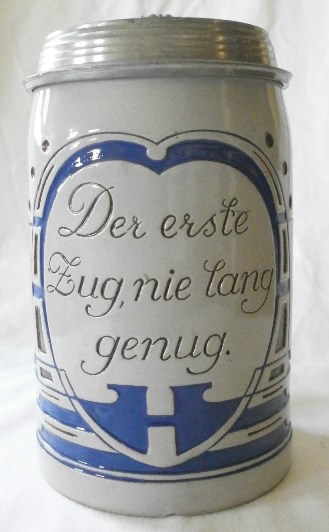
Gothic design / style (on drinking vessels) – Gothic in it’s original sense (and not these whacked out teenagers of today), means: “Of or relating to painting, sculpture, or other art forms prevalent in northern Europe from the 12th through the 15th century.” Shown: A 16 inch tall blown pink cut-to-clear German pokal with a cut Gothic arch design on the body [FWTD] – Yes, I know it needs a better photo.
“Go-with” – Mostly any item that is not a stein that compliments a stein collection, (or) a stein used with another collection that compliment it. “Mettlach” wall plaques are a go-with for V & B Mettlach steins; as are Reservist’s paper service certificates are to a “Regimental Stein Collection”.
See: http://www.steveonsteins.com/quick-look-at-some-of-the-brass-and-copper-go-withs-in-a-metal-beer-stein-collection
A very “mini”, pottery relief miniature stein (sans lid) as a “go with” to two small porcelain monks drinking, which could be part of a larger sub-set of stein collecting. I know one stein couple that have several hundreds of these little monks! [FWTD]
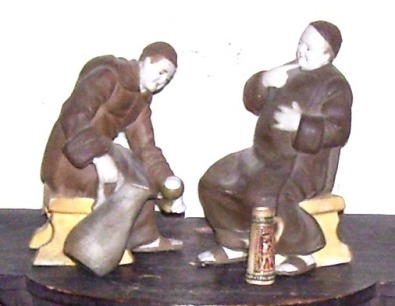
“G-R” mugs and jugs – (also “A-R”) – Saltglazed stoneware drinking vessels made in all sizes, for the English market in the Westerwald area of Germany for several hundreds of years. “G-R” stands for “Georg Rex” (KING GEORGE, I THROUGH IV). “A-R” is seen sometimes, for “Anne Regina.” These have been reproduced for decades and one needs to be an expert or have one in your pocket! when you buy any of these to determine its true age.
Shown above ▲, a great well kept example from the early1700’s. 6.5 “

Shown above ▲ ▲ and ▲: A very unusually designed “Sunflower” pattern jug. but only 6.3 inches. It has the right coloration of not a great kiln firing . and handle design of an authentic piece. Most of these jugs are a bit larger.
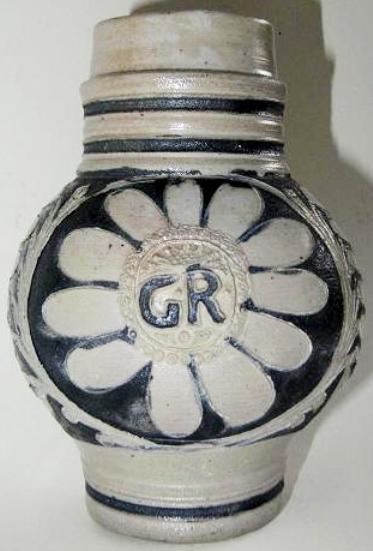
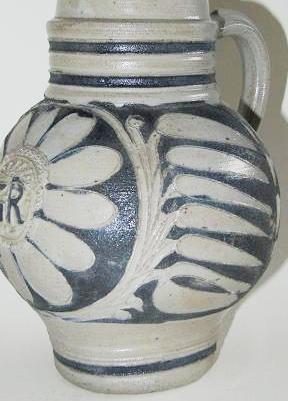
Shown ▲: A restored 9 inch “Anne Regina” jug, 1702-1714, the asking price was $1,000.00 I believe, in January 2009.
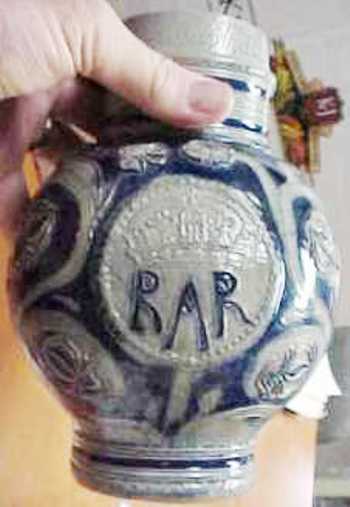
Shown ▲: A harder to find “G-R” mug with straight sided body. Mugs like this were the basis for the half a million [?, or more?] “Williamsburg Pottery” examples that were sold to tourists in Virginia over the last 25 -30 years.
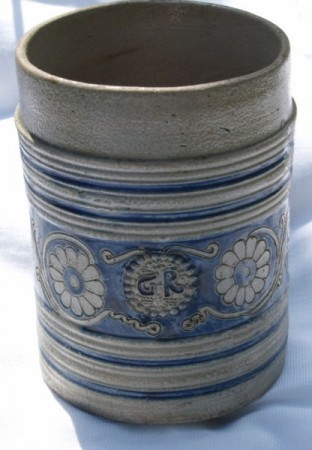
![A BEER STEIN GREEN MAN - MAJOLICA [1]](http://www.steveonsteins.com/wp-content/uploads/2011/01/A-BEER-STEIN-GREEN-MAN-MAJOLICA-1-450x337.jpg) with swords accompany him as he knocks on the doors of random houses, asking for presents but often getting thoroughly drenched by water instead. This pageant also ends when the boys draw their wooden swords and kill the green man. Another source says: This image or archetypal figure is commonly referred to as “The Green Man”, or leafy man, also called “Le Feuillou” in French, and in German the Green Man image is called “Blattqesicht. ” Shown: The neck of a majolica server with a green man That is not a beard of hair! [FWTD]
with swords accompany him as he knocks on the doors of random houses, asking for presents but often getting thoroughly drenched by water instead. This pageant also ends when the boys draw their wooden swords and kill the green man. Another source says: This image or archetypal figure is commonly referred to as “The Green Man”, or leafy man, also called “Le Feuillou” in French, and in German the Green Man image is called “Blattqesicht. ” Shown: The neck of a majolica server with a green man That is not a beard of hair! [FWTD]
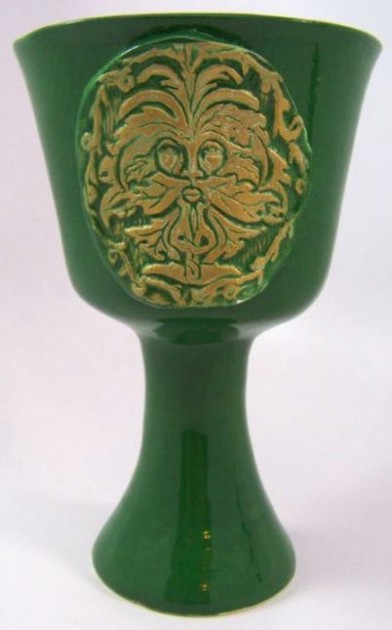
The Green Man on a 7 inch tall modern pottery relief goblet. In England the “Jack in the Green” is played by a man in a towering eight foot tall costume of leaves, topped by a masked face and a crown made out of flowers. He travels through the town accompanied by men whose hair, skin, and clothes are all green, and a young girl bearing flowers, dressed and painted entirely in black. Morris and clog dancers entertain the crowds, while the Jack — a trickster figure — romps and chases pretty girls, playing the fool. At length he reaches a mound in the woods below the local castle. The Morris dancers wield their wooden swords, striking the leaf man dead. A poem is recited over the creature solemnly, then merriment breaks out as each member of the crowd takes a leaf from the Jack for luck. (According to mythologist Sir James Frazer, “the killing of a tree spirit is always associated with a revival or resurrection of him in a more youthful and vigorous form.”) For more information, see: http://www.steveonsteins.com/the-green-man-vs-the-wild-man
Green Vaults, Nicest Stein The – Rooms in the Royal Palace of Dresden, Germany, that house an amazing collection of antique drinking vessels are known as The Green Vaults -it’ s original color when built. It displays one collection most from the 1400 through the 1600 ‘s. Lots of gold plated, ivory, and silver steins and some very old drinking horns abide there. Shown: An Ivory stein from ‘The Green Vaults’, silver mounts with a Bacchanalian scene. Often copied, and in many materials, such as just below in painted majolica. [a stein center photo] and below that one there are two copies shown made of iron, with painted copper – for display only ~ of course!! S M & T has two examples – one in Porcelain and one in bronze. SEE: http://www.steveonsteins.com/silver For 8 or 9 more different copies. ![SOS - GREEN VAULTS - SILVER PAGE [Q] MAJOLICA STEIN CENTER SAYS Made in Saxony, Germany by Collin [q]](http://www.steveonsteins.com/wp-content/uploads/2011/01/SOS-GREEN-VAULTS-SILVER-PAGE-Q-MAJOLICA-STEIN-CENTER-SAYS-Made-in-Saxony-Germany-by-Collin-q-630x344.jpg) ▲ ▲Majolica copy. probably Austrian Below ▼ painted iron examples.
▲ ▲Majolica copy. probably Austrian Below ▼ painted iron examples. ![SOS - GREEN VAULT'S [A] BACCHUS - PAINTED IRON WANTED MORE THAN $100](http://www.steveonsteins.com/wp-content/uploads/2011/01/SOS-GREEN-VAULTS-A-BACCHUS-PAINTED-IRON-WANTED-MORE-THAN-100-501x630.jpg)
![SOS - GREEN VAULT'S [B] BACCHUS - PAINTTED IRON WANTED MORE THAN $100.00 3-2011](http://www.steveonsteins.com/wp-content/uploads/2011/01/SOS-GREEN-VAULTS-B-BACCHUS-PAINTTED-IRON-WANTED-MORE-THAN-100.00-3-2011-420x630.jpg)
![SOS - GREEN VAULT'S [ [1] BACCHUS PAINTED COPPER BASE BE IRON](http://www.steveonsteins.com/wp-content/uploads/2011/01/SOS-GREEN-VAULTS-1-BACCHUS-PAINTED-COPPER-BASE-BE-IRON-501x630.jpg)
.
![SOS - GREEN VAULT'S [2] BACCHUS - PAINTED IRON UNDERSIDE](http://www.steveonsteins.com/wp-content/uploads/2011/01/SOS-GREEN-VAULTS-2-BACCHUS-PAINTED-IRON-UNDERSIDE-630x511.jpg)
Also See [1]: “Ginori” in this site’s Compendium.
Also see: [2] “Green Vault’s “= just above in case you missed it, for several more different material copies,
Greenware — Formed pottery that is air dried but unfired and, thus, still raw but drier clay.
Grenningloh – Maker of newer pewter steins with features of older piece such as this handle and enclosed hinge.
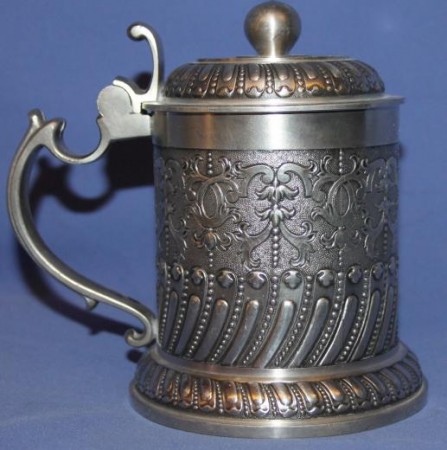
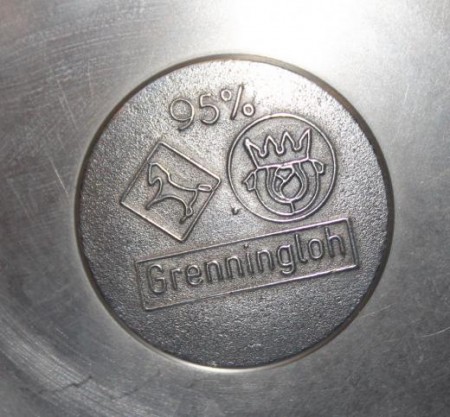
Griffin – Also: Gryphon – A mythological animal have the body of a lion with a head of an eagle and wings
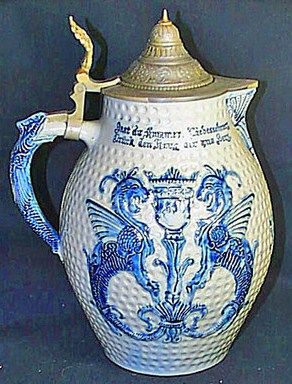
. Shown ▲: A pair of stylized Griffins on a Whites of Utica (American potters) beer server. The flattened) Griffin is the state animal shown on old Baden Reservist steins, and now on a lot of the newer reproductions on the market, shown below▼.
The Baden Griffin thumblift applied to a Bavarian striped (blue andwhite) repro stein.
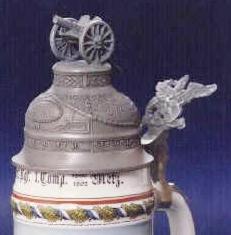
Gryphon Design Cobalt Blue On Grey. No mark. unknown maker smooth bottom no markDesign Cobalt Blue On Grey stoneware= Westerwald Ca. 1900-1920 unknown maker; smooth bottom.
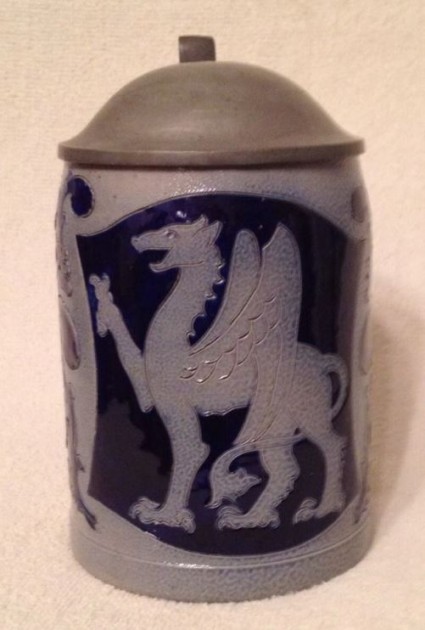
Grotesques – Fanciful and intricate designs loosely incorporating human figures, sphinxes, animals, foliage, etc., derived in the 16th century from Roman originals. Mostly found on steins as thumblifts or body decor. Not a gargoyle! For more see: http://www.steveonsteins.com/unusual-stein-thumblifts-1-3

“GROWLER”
Grower as An English term / word for a jug used to carry beer (in current usage, about a 2-liter or 64-ounce container with or without a handle; sometimes extended to similarly shaped 32-ounce jug, but not bottles).
ALSO, (UK, slang) The vulva. = NO PHOTO PROVIDED ,(although I have one or photo in my files I do not think I’d like it, as it would make the beer too warm!!!
A V&B Mettlach, stoneware, called a ” GROWLER” on eBay, but too small by definition) / a ceramic beer bottle marked Saarbrucken. Missing the front tin cap that holds the lid down.

Gueyton, Alexandre – SILVERSMITH, Paris, 1843-63, – while it is unusual for me to list a specific “white-smith (silver, pewter or copper) I do so when they are associated with a stein / vessel that is well known just by its form .
Such is the case with this one.
.800 silver and of a “Dutch outside life scene in heavy relief . It has been well copied. I have seen several versions in silver plate and some without plate either made that way or the silver has been polished off.
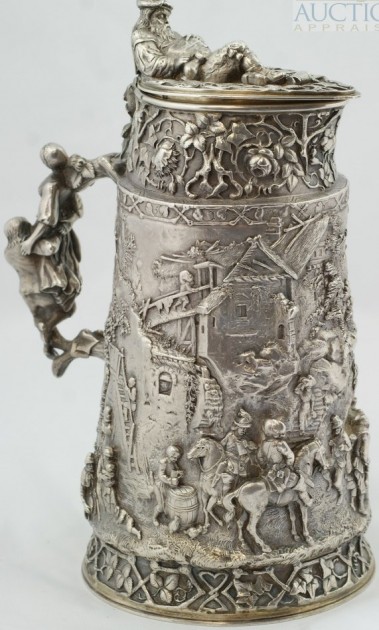
HANDLE PHOTO —YET ANOTHER PHOTO MISSING 11-18-14 = BY THIS P.O.S. WORD PRESS PROGRAM !]
note kept here on purpose trying to get a count [fall 2015]
![minerva or Mrs. Bartmann [a question]](http://www.steveonsteins.com/wp-content/uploads/2011/01/minerva-or-Mrs.-Bartmann-a-question-473x630.jpg)
The example above by Gueyton is marked with the Minerva head twice, dated on lid “AD 1851″, may have been exhibited and/or purchased at the London 1851 Great Exhibition. The body depicting a very complex mountain hunting party scene, the handle depicting a man carrying a maiden, the lid with a bearded man sleeping with a drinking vessel in his hand, 8 1/2” tall,
G.Th.M. Gebrüder [Brothers] Tannhauser, Munich) – Pewter-smiths in Munich, Germany during the late 1800’s. The company made very good quality beer stein lids.lots of them for the Theresiental Glashutte.such as above See: http://www.steinmarks.co.uk/pages/pv.asp?p=stein1
Guild poles, in Germany and Europe – A not too long but an interesting video on U-tube produced by Estse Gruppe (SCI Chpter in California) = http://www.youtube.com/watchv=YWV6nente3U
Guild cups, pokals, welcome cups, etc, – Here is a very brief but well done explanation of what The Guilds ” were all about. Medieval Guilds The guilds were an important part of city and town life. Guilds were •exclusive, regimented organizations; •created in part to preserve the rights and privileges of their members; and •separate and distinct from the civic governments, but since the functions and purposes of guild and civic government overlapped, it was not always easy to tell them apart, especially since many well-to-do guildsmen were prominent in civic government. Two kinds of guilds were especially important to civic life–merchant guilds and craft guilds. Merchant Guilds The merchant guilds were probably the first to appear and constituted the nucleus for civic organization. •As early as the 10th c. merchants formed organizations for mutual protection of their horses, wagons, and goods when travelling. •Often a merchant guild would found a town by obtaining a charter. Craft Guilds The craft guilds came about by increased specialization of industry. •A group of artisans engaged in the same occupation, e.g., bakers, cobblers, stone masons, carpenters, etc. would associate themselves together for protection and mutual aid. •As these craft associations became more important than the older merchant guilds, their leaders began to demand a share in civic leadership. •Soon no one within a town could practice a craft without belonging to the appropriate guild associations. •The purpose of the guilds was to maintain a monopoly of a particular craft especially against outsiders. For example, the harness makers would get together and figure out what the owners of business needed from that trade then allow as many masters to set up shop as the business could support. Consumer and Worker Protection In protecting its own members, the guilds protected the consumer as well. •Many craft regulations prevented poor workmanship. Each article had to be examined by a board of the guild and stamped as approved. •Because of lack of artificial light, work at night was prohibited. •In Florence the number of dyers was specified by the guild. In one place it was forbidden to see pigs fattened by a barber-surgeon lest the pig had been fattened on rich peoples’ blood. •Metalware plating was tantamount to fraud and, therefore, was forbidden. •To regulate competition between members the guild forbade advertising. •All prices were regulated •Craftsmen could take work outside where it could be seen. •Price-cutting was strictly forbidden. •To preserve its monopoly a guild forbade the sale of foreign artisans’ work within a city. •The most important processes used in manufacturing were guarded. In Florence a worker who possessed any essential trade secrets and for some reason fled to a foreign territory must be tracked down and killed lest he divulge the information. •Monopoly existed within individual guilds through the limitation of the number of masters. •No member was ever allowed to corner the market by purchasing a large supply of a product or commodity so as to be able to fix the price. Services Performed by Guilds Guilds performed other services for their members as well. They •provided funeral expenses for poorer members and aid to survivors; •provided dowries for poor girls; •covered members with a type of health insurance and provisions for care of the sick; •built chapels; •donated windows to local churches or cathedrals; •frequently helped in the actual construction of the churches; •watched over the morals of the members who indulged in gambling and usury; and •were important for their contribution to emergence of Western lay education. In earlier times, the only schools in existence had been the monastic or cathedral schools. Guilds and Community Interrelationships The members of the guild were called confraternities, brothers helping one another. From the political viewpoint, the guild was neither sovereign nor unrelated to society outside the guild and town organization. As a collective unit, the guild might be a vassal to a bishop, lord or king, as in Paris. The extent of vassalage depended on the degree of independence of the town where it was located. There was a close connection between the guild and the city authorities: •The City Council could intervene in event of trouble between guilds. •Council could establish the hours of work, fix prices, establish weights and measures •Guild officials were frequently appointed to serve in civic government because guilds usually voted as a unit, raised troops for the civic militia, and paid taxes as a group. Each guild was required to perform public services. They: •took turns policing the streets and •constructed public buildings and walls to defend the town or city. A perceived higher social status could be achieved through guild membership. The guildsmen of The Canterbury Tales had wives who liked to be called “Ma Dame” by their inferiors. By the 13th c. to become a guild man one had to go through 3 stages: •lowest was apprentice, •next was journeyman, and •top-ranking stage was master. The same structure is present in labor unions and colleges today. Apprentice — usually a male teenager who went to live with a master and his family; his parents paid to have him taken on. He probably occupied the attic of their 3 story home: •The shop where he would learn his trade was located on the ground floor. •The second story was the masters’ living area. •The third story housed the journeyman who was there to learn also. The apprentice was subject to the master. During his apprenticeship he was not allowed to marry. This learning period might vary from 2-7 years depending on the craft. His training included the rudiments of the trade. The apprentice then progressed to journeyman. Journeyman or day worker — entitled to earn a salary. The next hurdle was to produce a masterpiece that would satisfy the master of the guild so that he could assume the title of master craftsmen and would thus get membership in the guild. This was not easy to accomplish because: •The journeyman had to work on his own time to produce this masterpiece — Sunday was the only day he did not work sun-up to sun-down. •He must use his own tools and raw materials which required a capital outlay that he might not have been able to accomplish as a wage earner. •Then if he did produce the required work, the state of the economy guided the vote of acceptance — it was not desriable to have too many masters in a guild and when the economy was tight. The masters would not admit anyone to their ranks to strain the economy. Master–Once the masterpiece was completed and the guild voted to accept the journeyman as a master, he could become one. Information ▲ ▲ compl
ements of : “Chaucer” ► @ http://www.public.iastate.edu/~gbetcher/373/guilds.htm 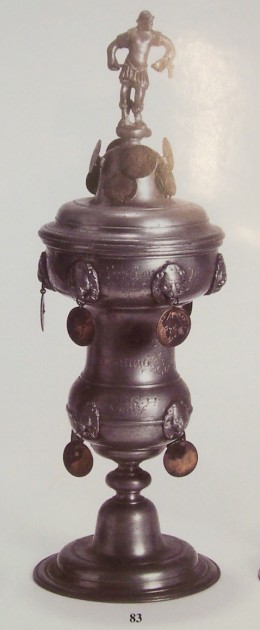 Above – probably the most typical form of “Guild Cup” to be found out there in 2015 +; and most have long since lost the hanging shields that indicated the leaders of the guild over time. And my DEAR READES, please remember they have been reproducing these for many, many years now. And please See: http://www.steveonsteins.com/future-4-the-famile-weygangs-steins-and-servers
Above – probably the most typical form of “Guild Cup” to be found out there in 2015 +; and most have long since lost the hanging shields that indicated the leaders of the guild over time. And my DEAR READES, please remember they have been reproducing these for many, many years now. And please See: http://www.steveonsteins.com/future-4-the-famile-weygangs-steins-and-servers
Authentic 1713 Boot Maker’s Guild pokal. 10 inches tall, [FWTD] INSCRIPTION BETWEEN TWO LIONS ON TO OF BODY: “JOHANNES FRENTZEL” , CUP SIZE WITH OUT LID: 9.25 INCH – WITH LID TO TOP OF WARRIOR FINIAL = 14.5 INCHES NOTE: COINS HAVE REPLACED THE ORIGINAL SHIELDS STILL HARD TO FIND A REAL ONE FORE SALE IN TODAYS MARKET.THERE ARE SEVEN OF THESE GERMAN COINS HANGING FROM THE MOLDED LION’S HEADS ON THE BODY. OF INTEREST IS THAT THEY ARE ALL OF A LATER DATE THAN THE 1713 DATE AND VERY WELL USED. THIS MEANS (TO ME): [1] THE ORIGINAL COINS OR MEDALLIONS, PROBABLY OF A HIGHER VALUE,MAYBE OF SILVER, WERE TAKEN OFF AND USED BY SOME LATER GENERATION (NOT UNUSUAL AT ALL)
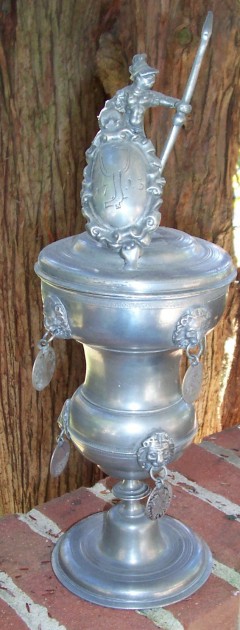
Detail of 1713 Boot Maker’s Guild’s insignia, AND yes that is a boot with a spur!
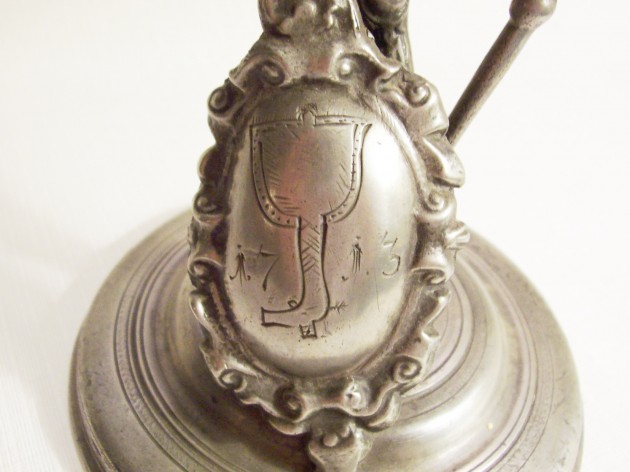
Pewter drinking boot made and initialed for a member of a Shoemaker’s Guild dated 1766. 9.5 Inches tall [FWTD]
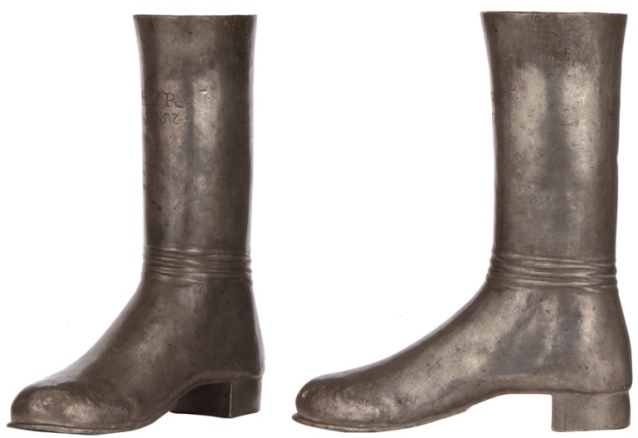
I AM ALWAYS SURPRISED AT THE PRIMITIVE CASTINGS OF THESE TYPES OF FINIALS. BELOW ARE OTHERS TAKEN FROM A JOHANNES VOGT’S CATALOG (MUNICH) FOR COMPARISON PURPOSES. 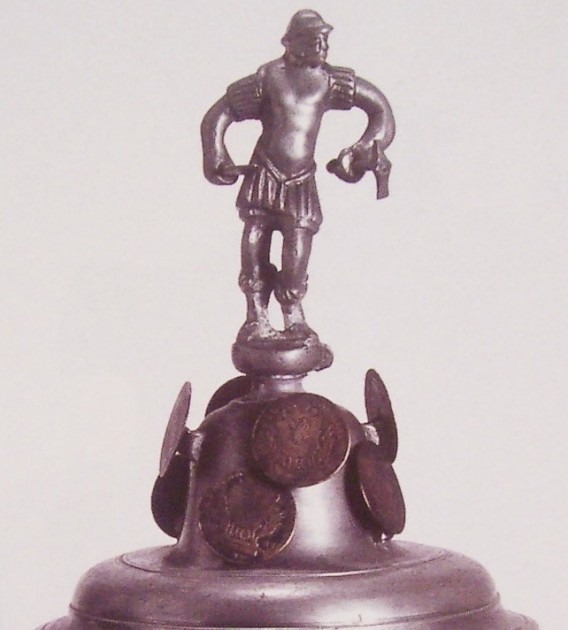 .
. 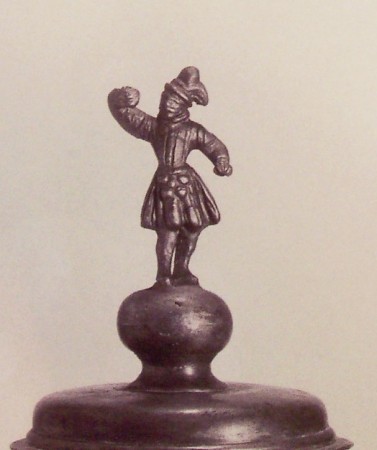
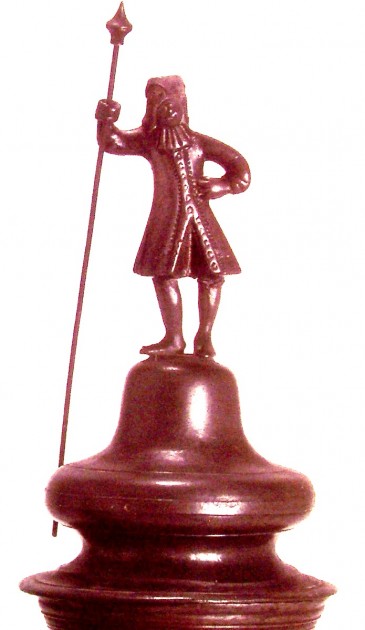 .
. 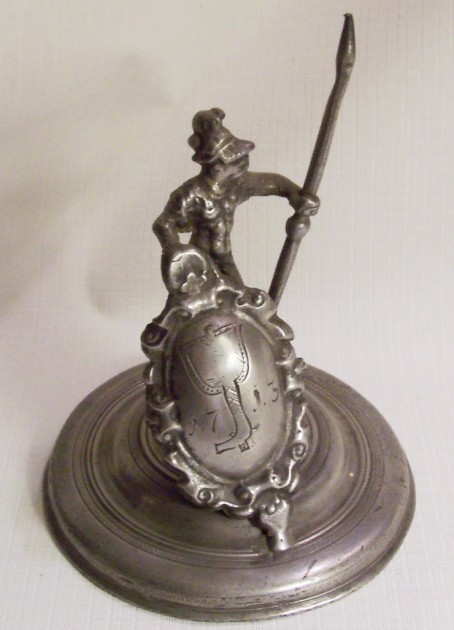 Guild flask – See: Brewer’s paddle.
Guild flask – See: Brewer’s paddle.
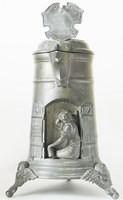 Guild steins (Not!): If the stein you or your collecting friends are calling a “Guild Stein” looks like this one (which was made by the Weygang Pewter-smith family in the 1800’s) then you are using the wrong terminology. One should me call these: “niche tankards” or “niche steins.” See the Tab: http://www.steveonsteins.com/future-4-the-famile-weygangs-steins-and-servers
Guild steins (Not!): If the stein you or your collecting friends are calling a “Guild Stein” looks like this one (which was made by the Weygang Pewter-smith family in the 1800’s) then you are using the wrong terminology. One should me call these: “niche tankards” or “niche steins.” See the Tab: http://www.steveonsteins.com/future-4-the-famile-weygangs-steins-and-servers
Some of the nicer (read that: VERY,VERY EXPENSIVE) real Guild steins look as below ▼:
Guard star – The frontispiece in shape of a star attached to the helmets of the Guard troops in the Imperial German Army. Small replicas of this star are sometimes found dangling from the Eagle’s beak on the finial or thumblift of a reservist’s stein.
Gustavsberg – A majolica mug manufacturer located in Sweden. See: http://www.steinmarks.co.uk/pages/pv.asp?p=stein1 Gunmetal – Hard, strong copper-tin-zinc alloy that is easily cast. The alloys now usually contain lead to improve machining characteristics and bearing properties.
[END – SP104 – 70 – R5] WISH TO CONTACT ME ? =

“Think of how dumb the average (50%)person is, and then try to realize half of all the others in the world are stupider than that!” It might help you get through the day, but wondering at night “How in the hell did we ever get to the moon?

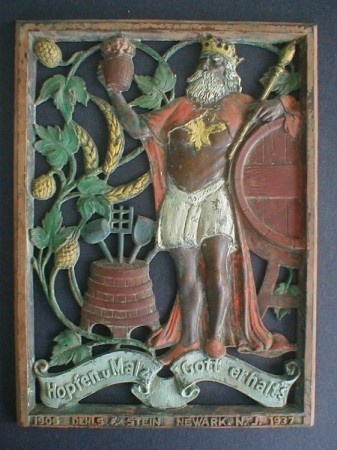
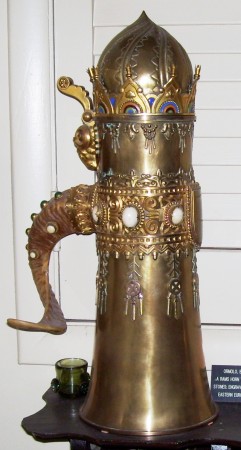
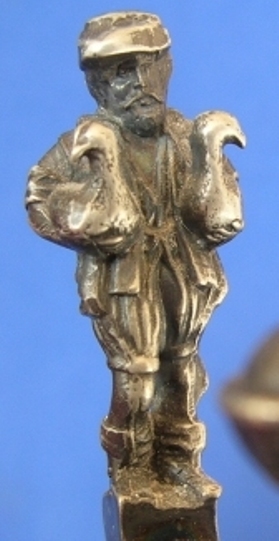
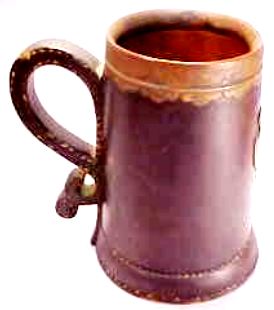
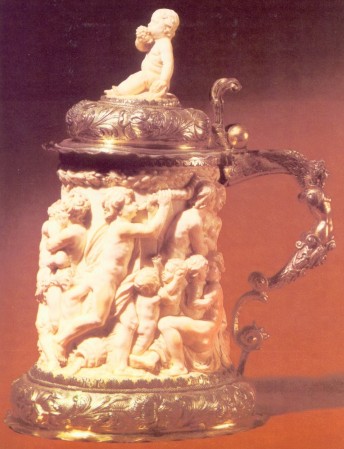
![1W G.Th. M. [q] -](http://www.steveonsteins.com/wp-content/uploads/2010/07/1W-G.Th.-M.-q-.jpg)
